Angels of history. When Benozzo Gozzoli painted a rapt band of angels in 1459, he, without hesitation, gave them softly undulant robes, splendid wings, and the further support of rainbow clouds. Obviously, Gozzoli, had likely never seen an angel himself. He was only following a well-established convention. But how did that convention grow up and what does it mean in the modern context?

Walter Benjamin:A Klee drawing named “Angelus Novus” shows an angel looking as though he is about to move away from something he is fixedly contemplating. His eyes are staring, his mouth is open, his wings are spread. This is how one pictures the angel of history. His face is turned toward the past. Where we perceive a chain of events, he sees one single catastrophe that keeps piling ruin upon ruin and hurls it in front of his feet. The angel would like to stay, awaken the dead, and make whole what has been smashed. But a storm is blowing from Paradise; it has got caught in his wings with such violence that the angel can no longer close them. The storm irresistibly propels him into the future to which his back is turned, while the pile of debris before him grows skyward. This storm is what we call progress. Read More:http://www.barglow.com/angel_of_history.htm
Barglow: Like Klee’s Angel,( Walter ) Benjamin felt caught in history’s tangle – propelled forward, yet incapable of disengaging from the past. Keeping in mind the self-destructive endpoint of his journey, we might reach the conclusion that our task is to put the past behind us and to resist melancholy’s regressive attraction to dissolution and death. Indeed, because of the terrible ways in which death typically occurs in the world as presently constituted, we have learned to associate it with everything bad: cruelty, violence, and defeat. Benjamin’s work, however, looks forward to a time when this association can be suspended, and melancholy and death recognized as creative as well as destructive forces. Read More:http://www.barglow.com/angel_of_history.htm
…So I, when vanished from man’s memory
Deep in some dark and sombre chest I lie,
An empty flagon they have cast aside,
Broken and soiled, the dust upon my pride,
Will be your shroud, beloved pestilence!
The witness of your might and virulence,
Sweet poison mixed by angels; bitter cup
Of life and death my heart has drunken up! ( Baudelaire, The Flask )

---This is the usual convention for painting angels since no one has ever seen them we assume they look like this and usually wear robes. In 1459, Benozzo Gozzoli painted this for the chapel of the Palazzo Medici-Riccardi in Florence.--- Read More:http://www.luckypalm.com/2009/italian-angel-painting-by-benozzo-gozzoli/
It is said that after we emerged from the cave, we looked up to the sky, and ever since, have been trying to reach it. Eventually, God’s voice was no longer the growl in the jungle, but the roar in the sky. God moved no longer in the galloping pack and in the terrible prowler, but in the thunderheads which held the furious lightning and in the mountain which jetted flame and shook the earth. God’s messengers, God’s companions, God himself now dwelt in the heavens, and when they visited mankind, they flew down from great heights and soared back again.
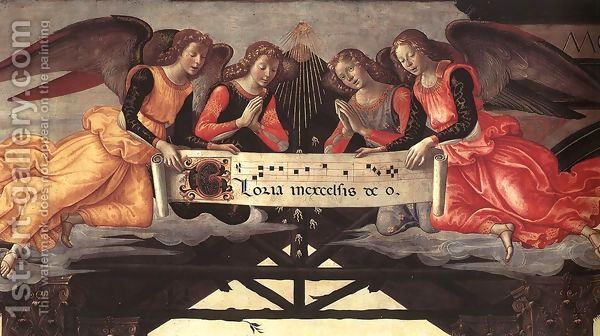
With Gloria in Excelsis Deo , on their lips, the angels of the Lord hover directly above the manger in this detail of Ghirlandaio Adoration of the Magi. 1488. Read More:http://www.1st-art-gallery.com/Domenico-Ghirlandaio/Adoration-Of-The-Magi-%28detail-7%29-1488.html
The Assyrian monarch’s palace was guarded by bulls with the bearded faces of men, and they had wings because they were the emanations of god. It was from the Assyrians that the Greeks learned how to portray a spirit as a man or woman with wings. Of course, the great Greek gods have no wings. Wings would degrade them. Zeus, Apollo and Artemis inhabit the regions of heaven as naturally as men walk the low earth: their dwelling is the sky-touching peak of Mount Olympus, unscalable and sacred. But other deities are winged such as Hermes, with his wings upon his heels. Eros is depicted by the Greeks as a capricious boy of twelve or thirteen, handsome, cruel, enchanting, naked and confident, with a powerful span of rapid wings on his bare shoulders….
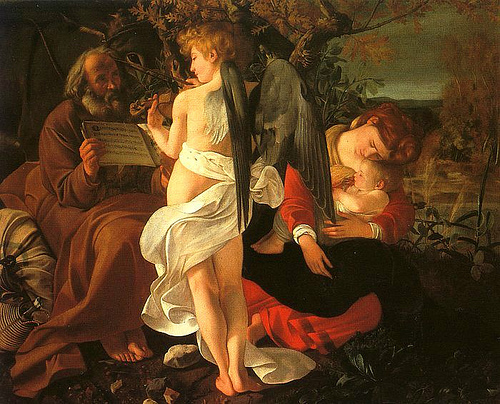
Caravaggio. Rest During the flight to Egypt. 1598. Read More:http://free4444.blogspot.com/2009/10/caravaggio-rest-during-flight-from_11.html
Barglow: In the historical project of liberation, Benjamin represents the Angel of History as being on our side – the angel wants to intervene but does not have the power to do so. Do we? Benjamin criticizes the pessimism that regards fundamental change as impossible and that tells us that historically, utopian dreams have been losing propositions. As an antidote to resignation, Benjamin proposes “the gift of fanning the spark of hope [that was] in the past,” as if memory could ignite a kind of prairie fire across the generations. Such memory is identified by Benjamin as “the quintessence of Judaism’s theological concept of history.” Embedded within Jewish tradition is extraordinary hope – Biblical accounts of Exodus and of the Maccabees, for instance, remind us that liberation movements can succeed against seemingly invincible power structures….At the end of this century, Benjamin’s Angel of History is still waiting for us to create the relationships – across the generations, across boundaries of every kind – that will enable him at last to take wing. Read More:http://www.barglow.com/angel_of_history.htma
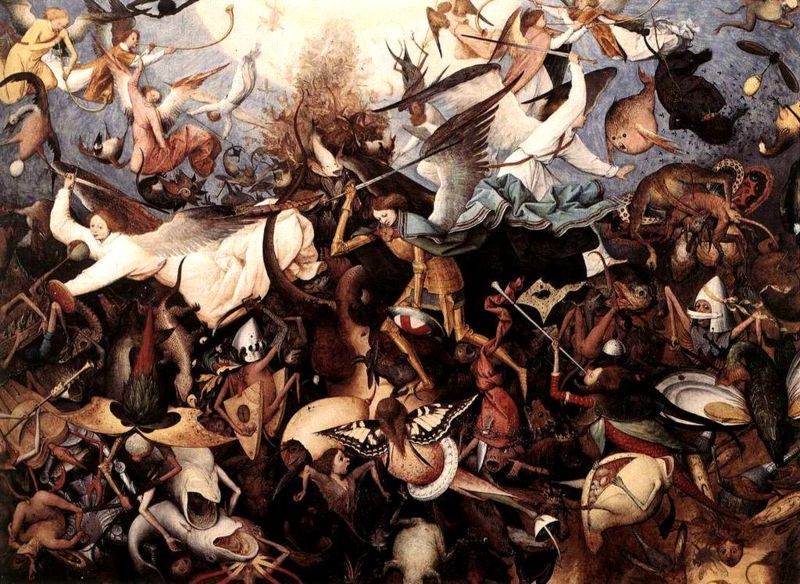
---Pieter Bruegel. ----Henry Giroux’s article on Walter Benjamin’s angel of history reads it in the light of the contemporary situation in America. Here is the crescendo: We no longer live in an age in which history's "winged messengers" bear witness to the suffering endured by millions and the conditions that allow such suffering to continue. Thinking about past and future has collapsed into a presentism in which the utter normalization of a punishing inequal
and the atomizing pleasures of instant gratification come together to erase both any notion of historical consciousness and any vestige of social and moral responsibility owed as much to future generations as to the dead. Read More:http://tornhalves.blogspot.com/2011/09/walter-benjamins-angel-of-history.html image:http://en.wikipedia.org/wiki/File:Pieter_Bruegel_the_Elder_-_The_Fall_of_the_Rebel_Angels.JPGAngel, teeming with gaiety, do you know grief,
Anguish, remorse and shame, their ravages and blights,
And the vague terrors of those panic-stricken nights
Which squeeze the heartstrings dry as a sere crumpled leaf?
Angel, teeming with gaiety, do you know grief?
Angel, teeming with kindliness, do you know hate,
Fists tight-clenched in the shadows, scalding tears of gall,
When Vengeance roars with his infernal battle-call,
Making himself the captain of our acts and fate?
Angel, teeming with kindliness, do you know hate?… ( Charles Baudelaire )
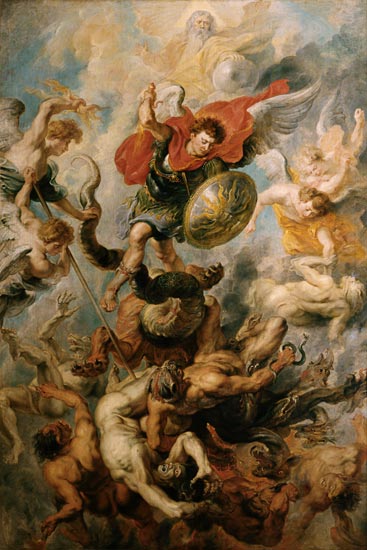
---Archangel Michael defeats the fallen angels by Rubens 288 x 433 cm, Munich, Alte Pinakothek---Read More:http://en.wikipedia.org/wiki/File:ArchangelRubens.jpg
And another spirit who is to politics what Eros is to personal life, has two great wings. She is the desirable, evasive, unpredictable deity who, with calmly smiling face, hovers like a noonday cloud above a battlefield bitter with blows and groans, and then, while the vanquished melt into heaps of corpses and sullen gangs of slaves, glides down a sunbeam to bring glory to the panting conquerors. She is among the fairest of all Greek images: Winged Victory. Victory has flown from conquest to conquest, proud breast bare and wings still flickering from her rapid descent from heaven.
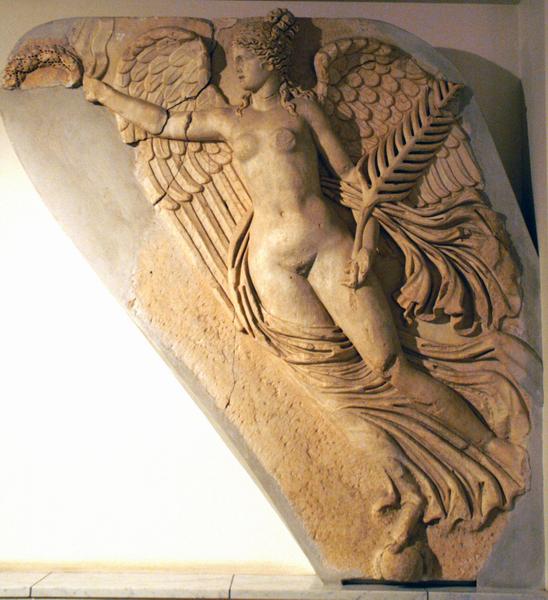
---This is the second Victory on the southwestern face. She carries a laurel wreath and a palm branch. The combination of conventional themes and unusual, almost rococo elements like the broken pediment suggest that the designer was born somewhere in the eastern provinces of the empire, where this type of decoration was less uncommon than in Italy.--- Read More:http://www.livius.org/le-lh/lepcis_magna/arch_severus.html
…Angel, teeming with healthfulness, do you know Fever
Who like an exile lopes with dragging step towards
The wan stark walls of hospitals and public wards,
Mumbling, seeking rare sunlight for a brace or lever?
Angel, teeming with healthfulness, do you know Fever?
Angel, teeming with loveliness, do you know wrinkles,
The fear of growing old, and, like a poisoned potion,
The dread of seeing love turn into fond devotion
In eyes adored, once blue and pure as periwinkles?
Angel, teeming with loveliness, do you know wrinkles?
Angel, teeming with happy, blithe, luminous airs,
David upon his deathbed would have craved for power
From the suave emanations of your body’s flower,
But I, angel, beseech of you only your prayers,
Angel, teeming with happy, blithe, luminous airs! ( Baudelaire )
ADDENDUM:
We may notice, however, a certain tension that animates the image: the eyes of the angel point toward the right, while the rest of the body twists slightly leftward, suggesting arrested movement, possibly a conflict between past and future. The staring, astonished quality of the face, with the mouth open, is also in keeping with Benjamin’s representation. He describes the angel’s view of the historical past as compressed: “Where we [humans] perceive a chain of events, he sees one single catastrophe that keeps piling wreckage on wreckage and hurls it in front of his feet.” To the angel there is available no gradual distancing from suffering that would allow its enormity to diminish. The horror is such that neither words nor images can ever represent it adequately.
The intensity of Benjamin’s description here suggests that he experienced the condition from which the Angel of History cannot escape as a personal as well as a political impasse. Although he did not go to prison or suffer any other severe repression on account of his beliefs or activities, his outlook on life is inseparable from the defeat of progressive forces in Germany in the 1920s, a decade prior to the seizure of power by the Fascists. I suspect that one of the reasons why Benjamin was so affected by his political surroundings is that he was either unable or unwilling to arrange the conventional compromises that shelter middle-class individuals from the fate of a proletariat more directly exposed to the cruelties of the class system. Even Benjamin’s theoretical investigations are radically subjective, as if the boundaries between private and public, between individual experience and the social world, exist only in order to be transgressed. Read More:http://www.barglow.com/angel_of_history.htm
Softly as brown-eyed Angels rove
I will return to thy alcove.
And glide upon the night to thee,
Treading the shadows silently.
And I will give to thee, my own,
Kisses as icy as the moon,
And the caresses of a snake
Cold gliding in the thorny brake.
And when returns the livid morn
Thou shalt find all my place forlorn
And chilly, till the falling night.
Others would rule by tenderness
Over thy life and youthfulness,
But I would conquer thee by fright!
( Charles Baudelaire, Ghosts)
—————————————
The Rebel
A furious Angel plunged from sky like a hawk,
Gripped the sinner with rough ahnds by the hair,
And shaking him, shouted, “You shall obey, do you hear?
I am your Guardian Angel. No back talk!
Learn to love (for you must, and no grimaces!)
The poor, the spitefull, the deformed, the dumb;
For you must spread for Jesus when he commes
A rich carpet of Charity where he pases.
That is Love! Before your heart expire,
Let the glory of God set it afire;
That is the true Delight that cannot rot!”
Then the Angel, cruel as kind,
With giant hands twisted him till he whined;
But the damned soul still answered “I will not!” ( Baudelaire )







 COMMENTS
COMMENTS